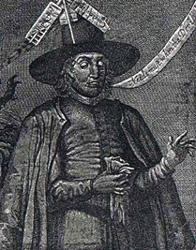     |
||
|---|---|---|
|
Genealogy Wynnes
|
Biography Thomas Wynne Dr. Thomas Wynne (July 20, 1627 -March 17, 1691) was personal physician of William Penn and one of the original settlers of Philadelphia in the Province of Pennsylvania. Born in Caerwys (Flintshire)Wales, where his family dated back fifteen generations, he accompanied Penn on his original journey to America on the ship Welcome. The fourth of five sons of Thomas Wynne Sr., Thomas Wynne lost his father at the age of 11. While attracted to the study of medicine early on. Heavy taxes levied on his family originally made the acquisition of proper learning materials difficult. He was able to make the acquaintance of an established surgeon by the name of Richard Moore, and soon he was able to apprentice until he was deemed worthy of licensing. Born into the Protestant faith, in 1655 at the age of 28 he married a Quaker, Martha Buttall (1627-1676), and found himself profoundly converted. Henceforth a devout Quaker and author of several pamphlets on Quaker doctrine, Wynne faced persecution and even six years' imprisonment in England in the 1680s. After his first wife Martha died, he married Mrs. Elizabeth Rowden (b. 1637; d. after 1691) on July 20, 1676, and she accompanied him as he joined Penn on his trip to America, leaving on August 30 and landing on October 27, 1682. Wynne was notable for erecting the first brick house in the colony, his "Liberty Lot" on Front and Chestnut streets (known as Wynne Street until renamed by Penn in 1684). He built a home on 52nd Street and Woodbine Avenue in 1690 named "Wynnestay" (a pun on the name of the famous Wynnstay estate in Wales), and several surrounding communities now bear his name. He served as speaker for the first two Pennsylvania Assemblies of the Province in Philadelphia in 1687 and 1688 and acted as Justice of Sussex county, now a county in Delaware, from 1687-1691. He followed Penn back to England on his trip in 1684. He was appointed a justice of the peace in January 1690 and held the position of justice of the provincial court from September 1690 until his death. His time in America lasted only nine years. He is buried at the Friends meeting house at Fourth and Arch Streets in Philadelphia.
|
|
